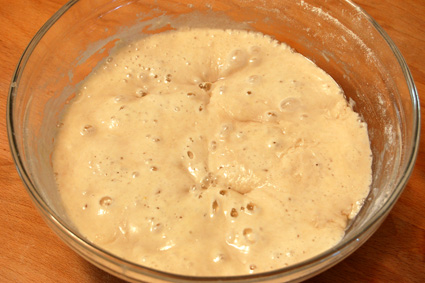In this case, I'm referring to the latest sourdough starter,1 not the Elton John song. Though that episode of This American Life where Starlee Kine and Jon Langford assemble a band from the classified ads to play "Rocketman" is pretty sweet. But I digress.
This is my second attempt at a sourdough starter, a few years after the last one succumbed to what I suspect was a bacterial infection. Regular time at home - necessary for the frequent feedings and baking a starter requires - had been in short supply from then until now. So far, so good, as you can see:

The summer heat, it seems, is moving the process along briskly. This may present some problems, especially over the long term, but I'll just have to wait and see. A sourdough starter is essentially a living colony of wild yeasts and bacteria - usually lactic acid bacteria, hence the "sour" quality - that offers a handful of pros and cons in bread baking. Some sourdough facts gleaned from Harold McGee's On Food And Cooking:
- The bacteria help delay staling, and the acids help prevent spoilage.
- The more acidic conditions of the dough reduce Maillard browning reactions, resulting in a lighter-colored loaf.
- Sourdoughs don't rise well; the bacterial populations outnumber the yeasts by several orders of magnitude, inhibiting gas production. In addition, the acids and protein-digesting enzymes weaken the dough's gluten network.
- Starters require frequent feedings, since microbes consume nutrients rapidly, and refreshing the starter dilutes the buildup of acids and other growth-inhibiting substances. Twice a day is the standard, though some starters may require more than that. Liquid starters, in which the microbes have easier access to nutrients, require more frequent attention than more solid starters.
- Starters work best for breadmaking when they're at their most active, bubbling away.
- Temperature control is important. Yeasts thrive best at 68-78°F; bacteria at 86-96°F. Thus, starters and rising doughs work best when kept relatively cool.
- Salt's a good thing. It limits the effects of the protein-digesting enzymes from the starter's bacteria, and helps tighten the gluten network.
Wild Yeast Sourdough StarterI'll try to post more as the sourdough-making process continues. Provided, of course, that I remember to feed The Bitch, or she'll die.
IngredientsDirections
- Bread flour
- Salt
- Water
- In a very clean, small mixing bowl, mix together ½ cup bread flour, ¼ cup room-temperature water, and ½ teaspoon salt. Stir together until you start to see signs of gluten formation - the development of stringiness and elasticity. Cover tightly with plastic wrap, and use the tip of a sharp knife to poke half a dozen holes in the plastic. Let stand at room temperature, away from drafts, for 12 hours.
- Mix another ½ cup bread flour, ¼ cup room-temperature water, and ½ teaspoon salt into the starter. Re-cover the bowl and let stand another 12 hours.
- Transfer the starter to a clean bowl, and stir in another feeding (½ cup bread flour, ¼ cup room-temperature water, and ½ teaspoon salt). Re-cover and let stand another twelve hours. If, by this point, the starter has not risen and started bubbling, discard and start over.
- Stir in another feeding, and cover the bowl with new plastic, without holes. Continue feeding, every 12 hours, for another day. The starter should have a slight sour aroma, and is best used when at its bubbliest, about halfway between feedings. If twice-daily feedings result in more starter than you can use, refrigerate and feed weekly.
* * * * *
1As I'd noted before, the name comes from Anthony Bourdain's Kitchen Confidential, and will, before long, result in a kitchen sign reading, "Feed The Bitch or she'll die!"
2No air conditioning. And the rather small basement keeps nice and toasty due to the oil furnace that provides us with hot water and, come wintertime, heat throughout the house. So, unless I come across an inexpensive secondhand refrigerator that I can override with a controllable thermostat, the starter'll just have to deal with ambient air temperatures. Unfortunately, the same limitations apply to homebrewing, which is decidedly less forgiving than bread baking - and which is all the more reason to keep my eyes open for a spare fridge.

No comments:
Post a Comment